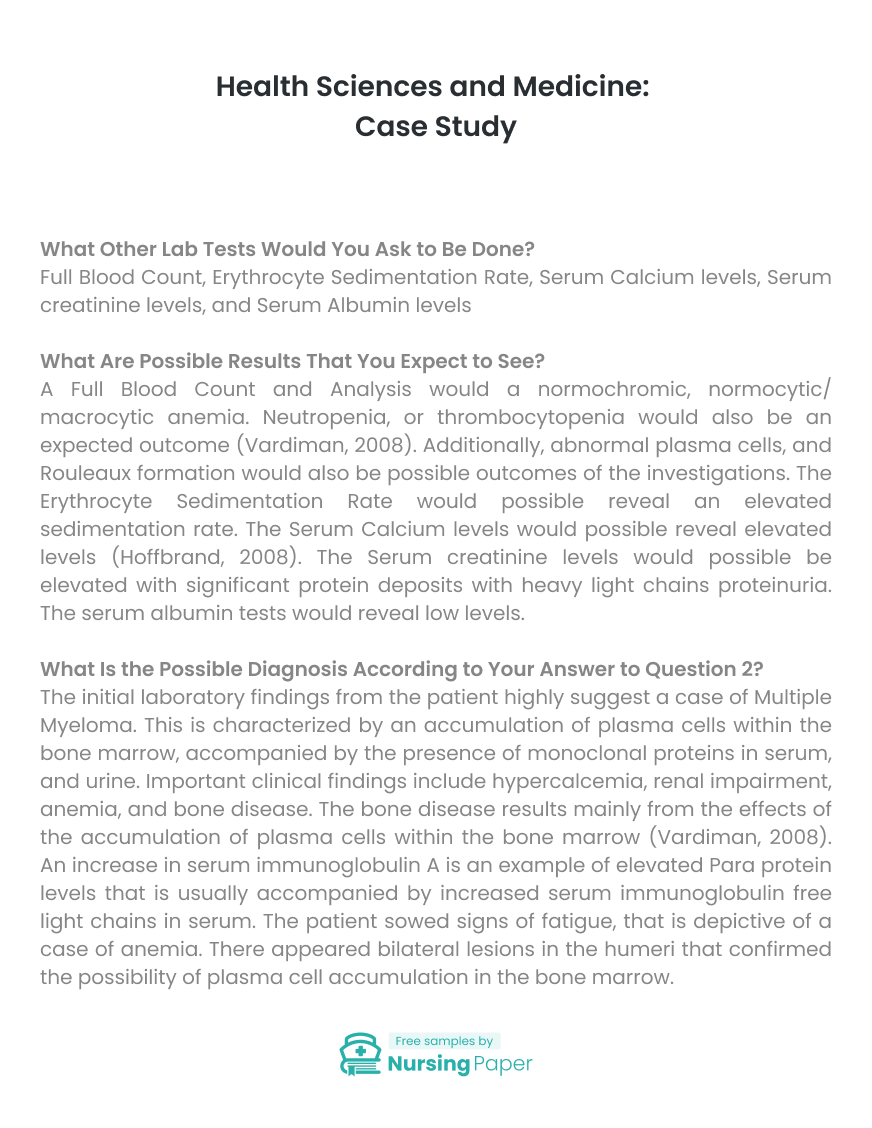
Health Sciences and Medicine: Case Study
What Other Lab Tests Would You Ask to Be Done?
Full Blood Count, Erythrocyte Sedimentation Rate, Serum Calcium levels, Serum creatinine levels, and Serum Albumin levels
What Are Possible Results That You Expect to See?
A Full Blood Count and Analysis would a normochromic, normocytic/macrocytic anemia. Neutropenia, or thrombocytopenia would also be an expected outcome (Vardiman, 2008). Additionally, abnormal plasma cells, and Rouleaux formation would also be possible outcomes of the investigations. The Erythrocyte Sedimentation Rate would possible reveal an elevated sedimentation rate. The Serum Calcium levels would possible reveal elevated levels (Hoffbrand, 2008). The Serum creatinine levels would possible be elevated with significant protein deposits with heavy light chains proteinuria. The serum albumin tests would reveal low levels.


What Is the Possible Diagnosis According to Your Answer to Question 2?
The initial laboratory findings from the patient highly suggest a case of Multiple Myeloma. This is characterized by an accumulation of plasma cells within the bone marrow, accompanied by the presence of monoclonal proteins in serum, and urine. Important clinical findings include hypercalcemia, renal impairment, anemia, and bone disease. The bone disease results mainly from the effects of the accumulation of plasma cells within the bone marrow (Vardiman, 2008). An increase in serum immunoglobulin A is an example of elevated Para protein levels that is usually accompanied by increased serum immunoglobulin free light chains in serum. The patient sowed signs of fatigue, that is depictive of a case of anemia. There appeared bilateral lesions in the humeri that confirmed the possibility of plasma cell accumulation in the bone marrow.
Further laboratory tests revealed an increase in the Erythrocyte Sedimentation Rate, Serum Calcium Levels, as well as Serum Creatinine levels. These are mainly attributable to the kidney function impairment that is significant in the case of Multiple Myeloma (Hoffbrand, 2008). At the same time, the impairment in kidney function would subsequently result in the loss of albumin hence low serum albumin levels. A full blood count showed a case of anemia. From the above clinical findings, a case of Multiple Myeloma would be highly suspected considering that the patient was above 40 years of age, while advanced age is an initial predisposing factor (Vardiman, 2008).
How Would Julia Be Treated According to Your Diagnosis?
The treatment of Multiple Myeloma involves either the use of specific or supportive interventions. The specific treatment approach in the management of the condition entails the use of combination therapy so as to reduce the rate of tumor growth and burden. Pharmacological agents such as Thalidomide, and Lenalidomide could be used. Also, other alkylating agents as Melphalan, and Cyclophosphamide could be used (Hoffbrand, 2008). The use of these pharmacological agents would involve taking patients through a series of treatment phases that run for a period of at least two years. Supportive treatments would involve the management of the various symptomatic manifestations (Vardiman, 2008). Renal failure would possibly be treated using rehydration, and subsequent management of the underlying causes. The fatigue, as a result of anemia, could be managed through blood transfusion. The bone diseases could be treated using pharmacological Bisphosphonates including pamidronate, aledronate. Finally, an increased vulnerability to the development of infections could be managed using antibiotic prophylaxis agents (Hoffbrand, 2008).

1. Hoffbrand A. (2008). Essentials of Hematology, p 273-284.
2. Vardiman JW, Thiele J, Arber DA, et al (2008): The 2008 revision of the World Health Organization (WHO) classification of myeloid neoplasms and acute leukaemia. Blood [A report providing the rationale for revision of the WHO classification of myeloid neoplasms.]



The download will start shortly.

The download will start shortly.
 Subject:
Medicine
Subject:
Medicine  Number of pages: 3
Number of pages: 3  Subject:
Medicine
Subject:
Medicine  Number of pages: 4
Number of pages: 4  Subject:
Medicine
Subject:
Medicine  Number of pages: 2
Number of pages: 2  Subject:
Medicine
Subject:
Medicine  Number of pages: 2
Number of pages: 2  Subject:
Medicine
Subject:
Medicine  Number of pages: 3
Number of pages: 3  Subject:
Health and Social Care
Subject:
Health and Social Care  Number of pages: 2
Number of pages: 2  Subject:
Medicine
Subject:
Medicine  Number of pages: 7
Number of pages: 7  Subject:
Health and Social Care
Subject:
Health and Social Care  Number of pages: 3
Number of pages: 3  Subject:
Nursing
Subject:
Nursing  Number of pages: 5
Number of pages: 5  Subject:
Medicine
Subject:
Medicine  Number of pages: 6
Number of pages: 6  Subject:
Health and Social Care
Subject:
Health and Social Care  Number of pages: 3
Number of pages: 3  Subject:
Health and Social Care
Subject:
Health and Social Care  Number of pages: 4
Number of pages: 4  Subject:
Medicine
Subject:
Medicine  Number of pages: 5
Number of pages: 5  Subject:
Health and Social Care
Subject:
Health and Social Care  Number of pages: 3
Number of pages: 3  Subject:
Medicine
Subject:
Medicine  Number of pages: 2
Number of pages: 2 
